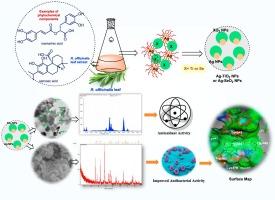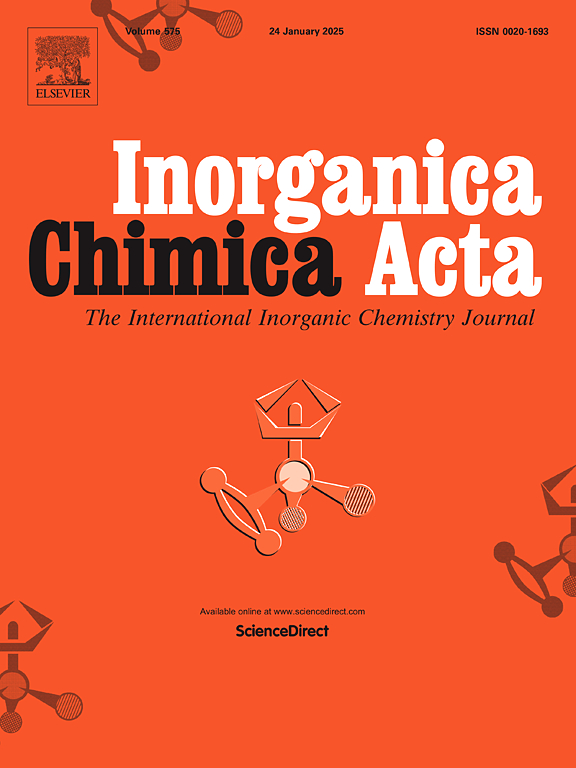Green synthesis and antimicrobial evaluation of Ag/TiO2 and Ag/SeO2 Core-Shell nanocomposites using r. Officinalis extract: A combined experimental and docking study
IF 2.7
3区 化学
Q2 CHEMISTRY, INORGANIC & NUCLEAR
引用次数: 0
Abstract
The escalating threat of antibiotic resistance necessitates the development of novel, sustainable antibacterial agents. This study investigates the potential of utilizing Rosmarinus officinalis leaf extracts to synthesize Ag/TiO2 and Ag/SeO2 nanocomposites. R. officinalis extract, a rich source of phenolic and flavonoid compounds, effectively and safely acts as a reducing and capping agent for the green synthesis of Ag/TiO2 and Ag/SeO2 nanocomposites. Characterization of nanocomposites revealed the nanoparticles’ nanoscale size, ranging from 43.34 to 96.58 nm for Ag/TiO2 and 8.04 to 21.72 nm for Ag/SeO2. Both types of nanoparticles exhibited a spherical morphology and distinct crystalline structure. The nanoparticles demonstrated significant antibacterial properties against multiple bacterial strains. The effective concentration for antibacterial activity was determined to be 30.99 mg/mL for Ag-TiO2 and 32.41 mg/mL for Ag-SeO2 nanoparticles. The surface charge of the nanoparticles was measured to be −14.0 mV for Ag-TiO2 and −15.4 mV for Ag/SeO2. Molecular docking simulations investigated the interactions between rosmarinic acid, its derivatives, and the antibiotic cefotaxime with a bacterial protein (e.g., DNA gyrase). These simulations provided insights into the distinct antibacterial mechanisms of these compounds. Briefly, this research highlights the potential of R. officinalis-derived nanocomposites as promising antibacterial agents. The eco-friendly synthesis and promising results pave the way for their development and application in medicine, biochemistry, and environmental fields.

利用R.O. Officinalis提取物绿色合成Ag/TiO2和Ag/SeO2核壳纳米复合材料并对其进行抗菌评价:实验与对接的综合研究提取物的 Ag/TiO2 和 Ag/SeO2 芯壳纳米复合材料的绿色合成与抗菌评价:实验与对接的综合研究
抗生素耐药性的威胁不断升级,因此有必要开发新型、可持续的抗菌剂。本研究探讨了利用迷迭香叶提取物合成 Ag/TiO2 和 Ag/SeO2 纳米复合材料的潜力。蔷薇叶提取物是酚类和类黄酮化合物的丰富来源,可有效、安全地用作还原剂和封端剂,用于 Ag/TiO2 和 Ag/SeO2 纳米复合材料的绿色合成。纳米复合材料的表征显示,Ag/TiO2 和 Ag/SeO2 纳米粒子的尺寸分别为 43.34 纳米至 96.58 纳米和 8.04 纳米至 21.72 纳米。两种纳米粒子都呈现球形形态和独特的晶体结构。纳米粒子对多种细菌菌株具有显著的抗菌特性。经测定,Ag-TiO2 和 Ag-SeO2 纳米粒子的有效抗菌浓度分别为 30.99 毫克/毫升和 32.41 毫克/毫升。经测量,Ag-TiO2 纳米粒子的表面电荷为-14.0 mV,Ag/SeO2 纳米粒子的表面电荷为-15.4 mV。分子对接模拟研究了迷迭香酸、其衍生物和抗生素头孢他啶与细菌蛋白质(如 DNA 回旋酶)之间的相互作用。这些模拟深入揭示了这些化合物的不同抗菌机制。简而言之,这项研究凸显了茜草提取的纳米复合材料作为抗菌剂的潜力。环保的合成方法和良好的结果为其在医学、生物化学和环境领域的开发和应用铺平了道路。
本文章由计算机程序翻译,如有差异,请以英文原文为准。
求助全文
约1分钟内获得全文
求助全文
来源期刊

Inorganica Chimica Acta
化学-无机化学与核化学
CiteScore
6.00
自引率
3.60%
发文量
440
审稿时长
35 days
期刊介绍:
Inorganica Chimica Acta is an established international forum for all aspects of advanced Inorganic Chemistry. Original papers of high scientific level and interest are published in the form of Articles and Reviews.
Topics covered include:
• chemistry of the main group elements and the d- and f-block metals, including the synthesis, characterization and reactivity of coordination, organometallic, biomimetic, supramolecular coordination compounds, including associated computational studies;
• synthesis, physico-chemical properties, applications of molecule-based nano-scaled clusters and nanomaterials designed using the principles of coordination chemistry, as well as coordination polymers (CPs), metal-organic frameworks (MOFs), metal-organic polyhedra (MPOs);
• reaction mechanisms and physico-chemical investigations computational studies of metalloenzymes and their models;
• applications of inorganic compounds, metallodrugs and molecule-based materials.
Papers composed primarily of structural reports will typically not be considered for publication.
 求助内容:
求助内容: 应助结果提醒方式:
应助结果提醒方式:


